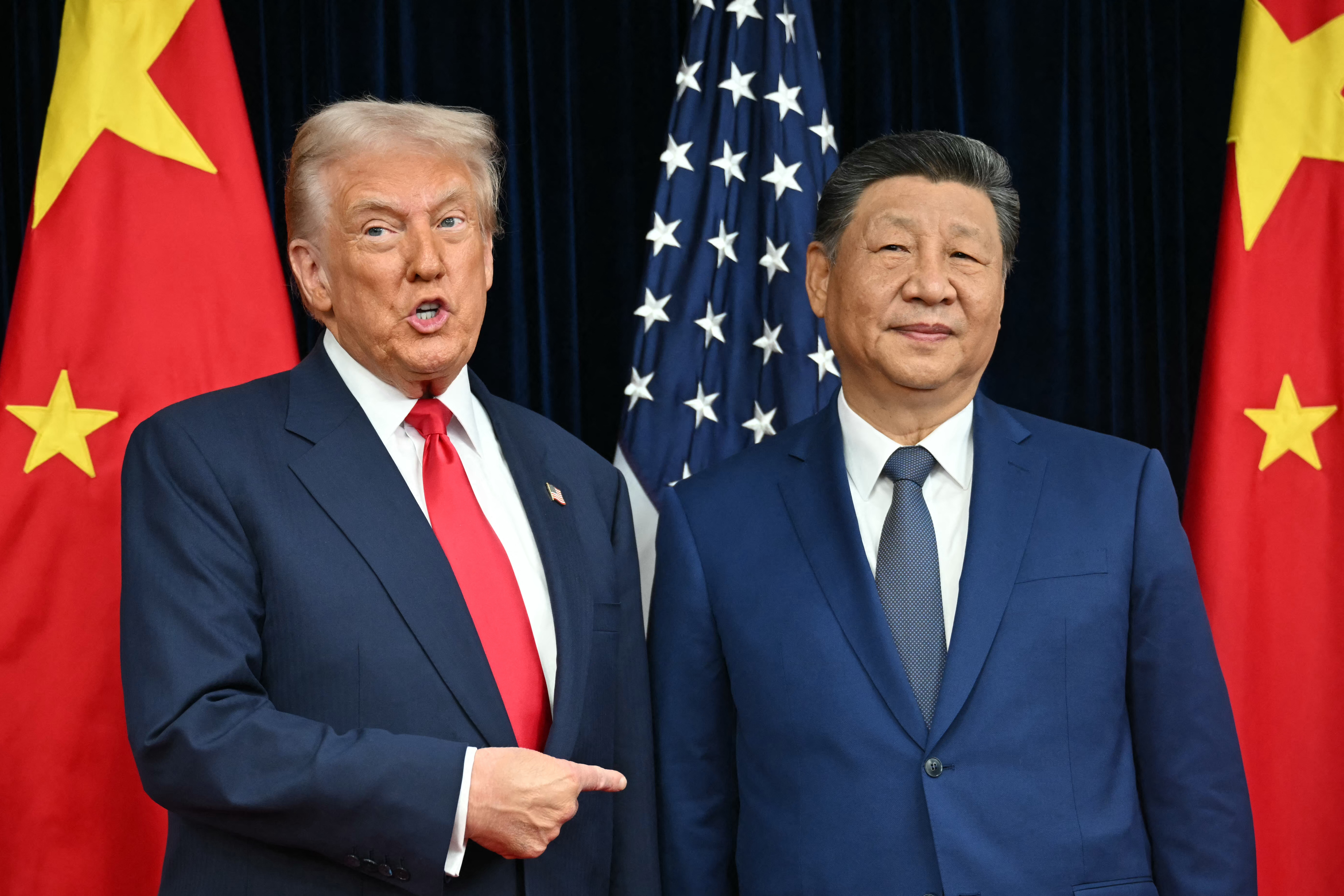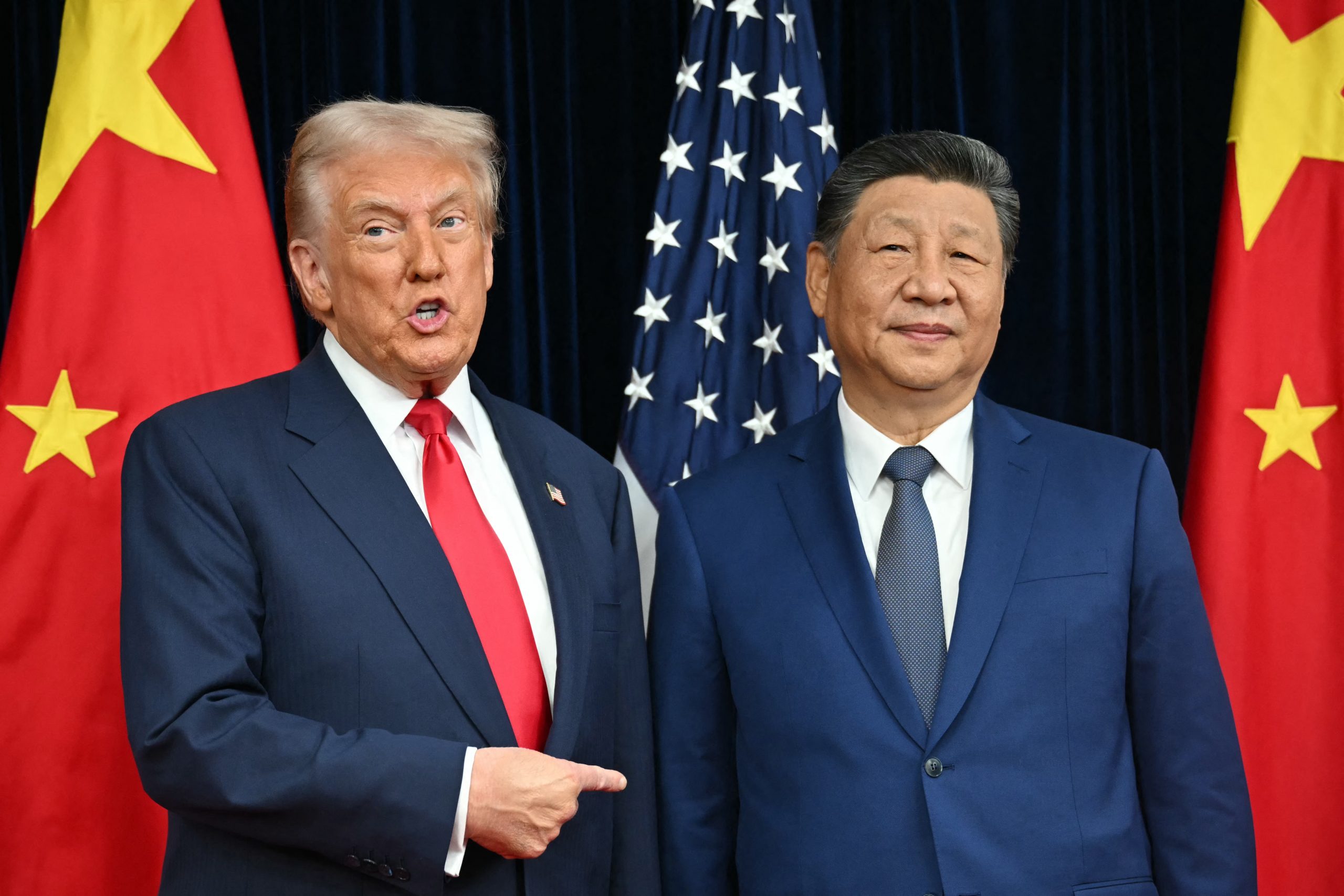
President Donald Trump said Thursday after meeting with Chinese President Xi Jinping that he was lowering tariffs in exchange for a crackdown on fentanyl and that he would visit China in April.
Speaking to reporters on Air Force One on his way back to Washington, Trump said he would reduce his fentanyl tariff on China to 10% from 20%, effective immediately, after Xi agreed to intensify China’s efforts to stem the illicit international flow of precursor chemicals for the deadly opioid.
He said his meeting with Xi was “amazing,” rating it a “12” on a scale of one to 10, and said that with few major obstacles remaining, a sweeping trade deal would soon be ready.
Trump said he would visit China in April, and that Xi would visit the United States “some time after that,” either at Mar-a-Lago or in Washington.
The meeting in South Korea between the two leaders, their first since Trump returned to the White House, lasted about an hour and 40 minutes and was the climax of Trump’s three-country Asia tour.
Some issues were not addressed at all, Trump said, including the status of Taiwan, the self-governing island democracy that Beijing claims as its territory.
Ahead of the meeting, some White House aides had worried that Trump might shift long-standing U.S. policy on the island in exchange for concessions from China, NBC News reported earlier this week.
Before the meeting, Trump called Xi a longtime friend and “tough negotiator.” His Chinese counterpart acknowledged “frictions” between the world’s two biggest economies, saying that “given our different national conditions, we do not always see eye to eye.”
Other tariffs remain, a White House official said, and there was also no mention of a deal on the popular Chinese-owned app TikTok, whose U.S. operations are required to be sold to a U.S. owner under a law that was passed last year based on national security concerns. Trump had said earlier that he and Xi might be able to reach one.
Both Trump and Xi wanted the optics and tactical aspect of this meeting to go well, a person familiar with the planning said beforehand.
Still, Trump is continuing a long-standing practice of meeting with allies before Beijing, which former Assistant Secretary of State Dave Stilwell said indicates that the U.S. is not going to trade its alliance commitments for a deal with China.
During Trump’s five-day trip to Malaysia, Japan and South Korea, he signed agreements with all three countries as well as Thailand and Cambodia; made new foreign investment announcements; and proclaimed that tariff leverage can drive warring parties to stand down.
Reflecting on his approach, Trump said going against the grain can sometimes deliver results.
“Oftentimes you’ll go the opposite way of almost everybody, and you’ll be the one that’s right, and the others will be the one that’s wrong,” he said in Gyeongju, South Korea, offering a peek into his thinking. “That’s where you have your greatest successes.”
Miles Yu, a former State Department adviser on China, said the U.S. and Beijing are “sizing each other out” with trade now a key battleground issue. Washington is pushing for concrete steps on fentanyl, market access and more, he said, while China “stonewalls and foot-drags” and offers only broad “frameworks.”
“This is the root cause of the five rounds of futile negotiations so far with China without a breakthrough,” Yu said, adding that the administration is trying to shift China’s approach by rallying its neighbors, a strategy that he said “may or may not work.”
After talks with Chinese counterparts in Malaysia last weekend, Treasury Secretary Scott Bessent said negotiators had shaped a framework for Trump and Xi to consider that spanned tariffs, trade, fentanyl, rare earths and “substantial” purchases of U.S. agricultural products.
He credited Trump’s threat of an additional 100% tariff with creating leverage and said he believed that the framework would avoid that outcome and open space for tackling other issues.
Xi said Thursday that the framework agreed in Malaysia had “provided the necessary conditions for our meeting today.”
Dan Caldwell, a former senior adviser to U.S. Defense Secretary Pete Hegseth, said Trump deserved credit for pursuing a pragmatic China policy that maintained what he said was strategic ambiguity while taking steps to restore important military capabilities to deter Chinese aggression.
“A lot of folks wanted to assume that he was going to be reflexively hawkish on China,” Caldwell said of Trump. “That hasn’t been the case.”
But Caldwell cautioned against expecting a breakthrough in Busan. “I don’t think the overall push hinges on one meeting,” Caldwell said. “Ideally, these go well, but the whole thing does not hinge on just one set of talks.”
In other words, the goal was to make enough progress to get to the next date between the two leaders.
Analysts in the region, too, saw limited room for a sweeping agreement this week.
“Some sort of consensus and agreements are very possible,” said Zeng Jinghan, a professor of international relations at the City University of Hong Kong, given that both sides want “a little bit of de-escalation.”
But Trump and Xi were unlikely to reach a comprehensive deal that settles the long-term structural differences between their countries, he said.
The hope instead is for “less aggressive” rhetoric, Zeng said, with both Beijing and Washington likely to come back and declare the meeting a success.

Allison Craig is a passionate sports writer and analyst with a deep love for game strategies, player performances, and the latest trends in the sports world. With years of experience covering football, basketball, tennis, and more, she delivers insightful analysis and engaging content for sports enthusiasts.


No responses yet